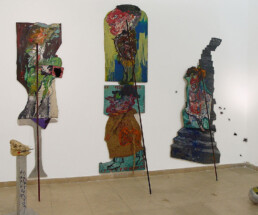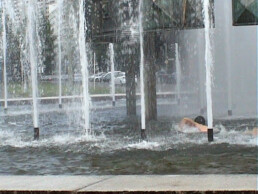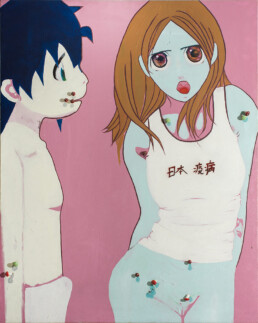ALEKSANDAR JESTROVIĆ JAMESDIN (1972)
Holy Fathers
mixed media
320 cm x 300 cm
2002
Smuggle Trade
video, painting, drawing
variable dimensions
2009–2014
Holy Fathers
mixed media
320 cm x 300 cm
2002
Here’s the thing about the work Holy Fathers, I will now briefly tell you what I remember about making it. Let’s say that it was made under the influence of fresco painting and the idea that elongated figures symbolize spirituality. I achieved this by placing one figure on top of another. I placed the woman on the table, the old woman on the stairs or the young man who climbed on the old man’s head, and I supported them all with sticks, which are there so that they do not fall. In the compositions in churches, the Holy Fathers are all male; here, it is half-and-half.
Aleksandar Jestrović Jamesdin
© Cultural Centre of Belgrade, the October Salon Collection and the artist
Gift Contract: III-5-287/1/22.9.2014.
Inventory No. 1345
Photo: Courtesy of the artist
Smuggle Trade
video, painting, drawing
variable dimensions
2009–2014
I don’t know any longer where to and how I’ve managed to drag all these works, for if it’s not Požega or Smederevo, you always need some kind of permit or other. And now that I live across the border, it’s even more of a hassle, I’ve been debating with these retards of ours on the border crossing whether it’s an oil on canvas or an acrylic painting, and whether it’s finished or just started; they are the very same Bosnian Comancheros from the Kelebija crossing who wanted to send me back to Bosnia on a truck in ‘95, for I was born in Zagreb. It was even worse with those Hungarian nationalists – I was only centimetres away from a rectal examination. I somehow managed to convince those idiots on the Croatian border that I’m one of them and that I have a studio in the Croatian Zagorje region, the stress of it all cost my curator, who was driving me then, a bout of diarrhoea. I guess I’d better not even mention those poor wretches on the Slovenian border, who are trying to practise Austro-Hungarian strictness… And when, after all that jerking off, you don’t even come to see the exhibition, well, I feel like committing suicide.
Aleksandar Jestrović Jamesdin
© Cultural Centre of Belgrade, the October Salon Collection and the artist
Purchase Contract: III-5-476/1/15.12.2014.
Inventory No. 1380
Photo: still from the video work, Milan Kralj, installation view 53rd October Salon, Ana Kostić
Japanese Plague
oil on canvas
110 cm x 86 cm
2008
The work is inspired by the fear of disease, which, along with the fear of war, is still widely present here, as in other Third World countries. I came to that conclusion when I talked to a friend who is my age and with the same education, who dropped art and is engaged in video production. He confided in me that he came up with the concept of the show in which he would deal with the most common health problems of our generation (early thirties), because in communication with friends he noticed that everyone has them, that is, that no one is healthy here.
Aleksandar Jestrović Jamesdin
© Cultural Centre of Belgrade, the October Salon Collection and the artist
Gift Contract: III-5-37/5.12.2020.
Inventory No.
Photo: Milan Kralj
ABOUT THE AUTHOR:
Aleksandar Jestrović or Jamesdin (1972, Zagreb, SFRY) graduated in painting from the Faculty of Fine Arts in Belgrade, under Professor Čedomir Vasić. He obtained a master’s degree at the Institute for Art in Context UDK Berlin, in the class of Assistant Professor Wolfgang Knapp. Since 1999, he has presented his works at 17 solo and over 100 group exhibitions in Serbia and abroad and won several significant awards. Served in the army, never convicted, married. Lives and works in Berlin and Belgrade. More information at: https://jamesdin.wordpress.com/
He participated in the 50th and 53rd October Salons and won the Cultural Centre of Belgrade Award at the 50th October Salon. The jury’s citation reads:
The jury’s decision is based on the desire to recognize the art practice that produces difference, and due to the fact that Jamesdin’s production “is created through a reflection of multiplied and unsystematized” personal and cultural references that surround him and that are an act of performativity, not a sublimated result.


